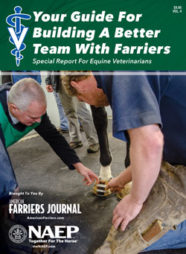Farriers today are much more willing to share information. Decades ago, shoeing was a tight-lipped industry. Veteran farriers were the only means of communication for a new shoer and they weren’t often willing to talk. Now, farriers are sharing knowledge through local associations, general camaraderie and other venues, like clinics and conferences. Shoers today recognize the importance of sharing knowledge for the good of the industry and the horses.
Working Together
Steve Sermersheim (CJF, AWCF) of Collison, Ill., a 24-year farrier, says the best way to develop a professional relationship with veteran shoers is to learn from them. Offer to ride with a local farrier a day or two a week and help out. That way you get to demonstrate your work. You’ll also have an expert on hand for critiques and improvements.
“That will build your business faster than trying to advertise,” says Sermersheim. “Go ride with established farriers and show them your skills. Pick up the phone and call them. Introduce yourself and say you’re willing to learn. Let them know you’re available for extra horses.”
He finds the biggest mistake new farriers can make is isolating themselves from the farrier community. By working with others, a farrier gets to know clients and builds a network of mentors who will be available if issues arise. “If you run into any problems, there will be people to ask,” he says.
Doug Anderson (CF, APF), a farrier with 14 years of experience, believes that riding with veteran farriers is what makes every great horseshoer great.
“The veterans are going to throw every kind of horse at you,” he says. “Young farriers need to be willing to shoe horses that no one else wants to shoe. You’re not going to come out of farrier school working the cream of the crop. It takes a willingness to eat a little crow, to start at the bottom of the ladder and climb to the top.”
Hard Work Will Pay Off
“Because I established relationships with farriers when I started out, I knew how much each owner paid, I knew their working conditions, and I knew the temperament of the horses,” he says.
It goes back to increased communication between shoers. The Frederick, Md., shoer is happy to report that farriers are starting to see each other as colleagues over competitors. “It’s all about sharing information. Let’s make everybody’s trick bag a little bigger,” he says.
Talking Ill Of Others
Growing as a professional farrier also means not speaking poorly of another’s work. Jeff Ridley (APF, CJF TE), a 19-year farrier in Leighton, Iowa, says a farrier should avoid doing so because you don’t know the conditions the shoer was given. Every farrier has his or her own style and finesse, and every shoeing situation is unique. Refuse to evaluate fellow shoers. It is unprofessional and it could be costly to your business.
Bad-mouthing a shoer can cost a farrier the respect of their client base and shoeing community.
“I have never, ever seen any benefit from a shoer running another down,” says Anderson.
“If I ran my mouth off to a horse owner, chances are it’s going to further drive the owner into that farrier’s corner. People aren’t dumb. We’re a service business. If you’re throwing others in your field under the bus, why wouldn’t you throw a client down there as well?”
Anderson stresses showing farriers respect, in and out of the workplace. “Horsehoers are funny,” he says. “They won’t show you respect until you show it to them.”
The easiest way to lose a farrier’s respect is to poach clients away. Bad-mouthing and even falsely discrediting a fellow shoer to gain business is the fastest way to get ostracized from the farrier community.
“If a client decides to switch, that’s one thing,” says Anderson. “If a shoer is actively taking my client away, it’s just frowned upon. You’re taking away from what I need to provide for my family. Farriers will go out of their way to hinder those who poach.”
Finding Clients

Pat Burton, left, answers a question for his client. He finds listening and responding to clients is a way to improve your professionalism.
Do not limit connections to fellow farriers. Talk to local veterinarians and establish connections with them. Vets in your area can prove to be a great resource for both routine referrals and specialty therapeutic work, says Pat Burton (CJF) of Burleson, Texas. Building up a referral system is key. To expand your client base, think about rewarding referrals.
“Send a personal note of appreciation along with a gift card to a restaurant, Starbucks or a $20 coupon on your business, good for use on their next appointment. Do this for clients, veterinarians, feed store employees and watch your referrals increase dramatically. Over 60% of my new clients come from personal referral,” says the 34-year veteran.
First Taste Of Success
Anderson tells young farriers not to rest on the laurels of their initial success. Shoers should always strive for improvement, whether it’s in their performance or their professionalism. Stay humble and never stop being your own worst critic.
“You get out there and see a little success and your books are getting full. Next thing you know, you’re too busy, and your work suffers,” he says. “If you’re not shoeing the best you can, regardless of how busy you are, you’re shooting yourself in the foot.”
Anderson cautions that farriers are only as good as their last shoeing. Word of mouth will spread much quicker for a bad shoeing than it will a good one.
“Farriers forget that we need to treat others and horses the way we want to be treated. I want clients to think I’m the best service professional in the world. If they don’t, I know I need improvement.”
Undercutting Prices
New farriers often have the temptation to undercut prices to work their way into the market. You can set your prices low, but the work will catch up to your pricing. Low-end pricing will mean working on low-end horses.
“The amount of money you charge dictates the horses you work on,” says Jeff Ridley. “If you want to make it in this business, you need to be working on horses that get taken care of consistently. You need to work with people that are willing to pay for quality care.”
Undercutting also presents an economical challenge. Once a farrier sets prices low, it’s hard to work their way up to other shoers’ prices. It’s also hard for a farrier to manage business operations.
“If you’re trying to make a living, you have to charge money,” says Ridley. “You have to think of fuel, tires, insurance and retirement.”
Taking On Others’ Clients
If a farrier exercises ethical business practices, don’t be ashamed when you are hired to replace a fellow shoer. At one point, a hired farrier will replace another. It’s the nature of business. The goal of any successful business is to draw work to yourself. At the same time, a farrier should be conscientious of the one he or she replaced.
“If I’m taking another shoer’s client, I always make a phone call,” says Anderson. “I look into why the client changed farriers. If I question the switch, I need to talk to the other shoer. It goes back to camaraderie and respect. Clients are happy to lie to us all day long. If a reason bothers me, I need to talk to the other shoer.”
Anderson points out that clients don’t often tell shoers why they’ve chosen another, and this hurts a shoer’s learning process. “I want to let the shoer know why a client switched, because often the other shoer has no idea. The client is avoiding them. But if I can pass along information that’s going to help a shoer improve his work, I’m going to do it.”
You’re Fired
Don’t overreact if you are fired. Clients will let farriers go for a number of reasons unrelated to their work. However, don’t assume that every time you are fired that it was unjustified. Evaluate your performance. What could you have done differently to satisfy that owner? Or what makes another farrier more appealing to the client?
Ridley believes a firing should always be taken with an open mind.
“Clients often change farriers and it has nothing to do with the work,” he says. “You can’t let a firing bother you. If a client comes back, don’t take it personally. If there’s a new guy in town, they might try him. And they might come back. It’s not a personal thing, it’s business.”
Anderson agrees and believes that firings can be another tool for improvement. Call the farrier that has taken your work. Exchange information about the horses and ask if your work needs any improvement.
“Give the shoer a call and say ‘I need your help,’” he advises. “I might be doing something wrong and I need to know how to fix it. I’ll ask hard questions. I’m ready for the answers, and I’m always ready for improving my work.”
Anderson also warns against baring animosity toward the shoer who replaces you. There are countless reasons why farriers lose clients. If farriers continually craft their skills, their business will have stability rather than having to worry over clients who continually switch farriers.






